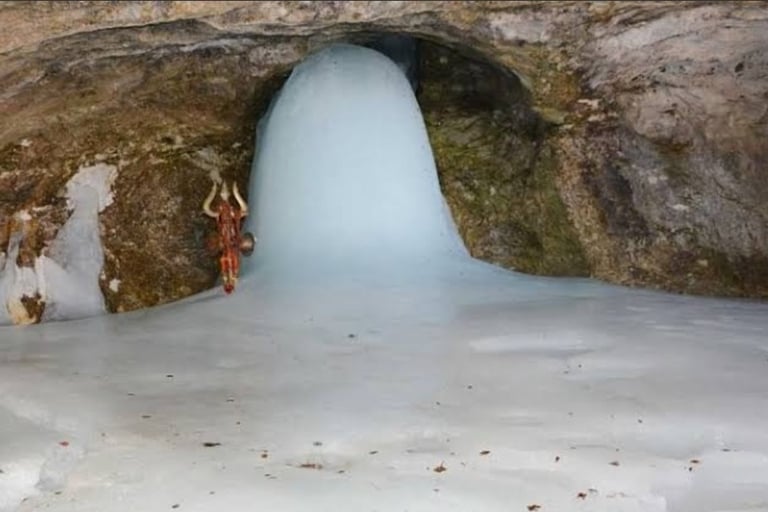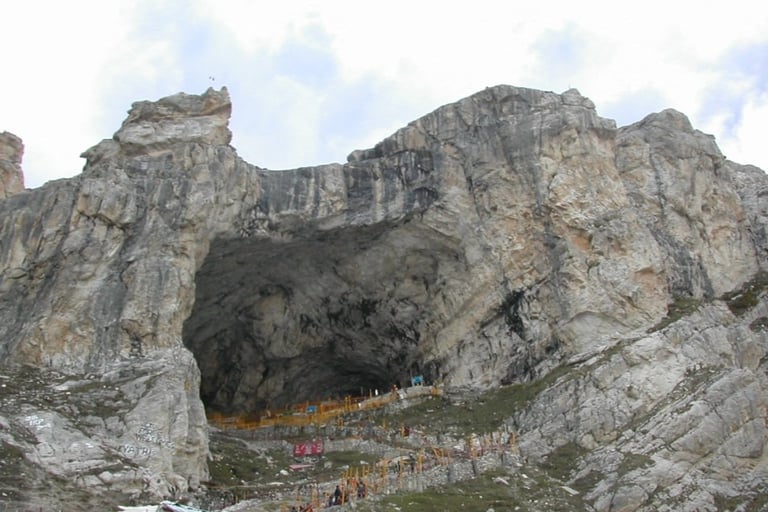Amarnath Yatra: Faith, Risk, and Responsibility
The Amarnath Yatra reminds us that faith is more than reaching a sacred place; it’s about how gently we walk through it. As pilgrims or as readers, may we carry back not just blessings, but a promise to protect the mountains, the rivers, and the silent paths that make such moments of devotion possible. In reverence, may we also find responsibility.
CULTUROSCOPE
Each summer, as snow recedes from the upper reaches of the Himalayas, pilgrims begin a demanding ascent toward a small limestone cave high above sea level. Inside this cave, water drips steadily from the stone ceiling and slowly freezes, forming a slender column of ice known as the ice lingam of Amarnath. It isn’t shaped by any human hand; it appears on its own, lingers for a while, and then quietly melts away, a sight that, for many who come from far and near, captures both the hope and the uncertainty woven into faith itself.
Legend tells that in this hidden cave, Lord Shiva shared with Parvati the secret of immortality, the Amar Katha. Before speaking, he is said to have set aside all that tied him to the world: his sacred bull Nandi, the crescent moon on his matted hair, even the snake coiled around his neck. Tradition says he also let go of the five elements — earth, water, fire, air, and space so that the secret would remain truly secret. Yet, despite this care, two pigeons are believed to have overheard the divine conversation and, by that chance alone, were granted immortality. Their quiet story still lingers among pilgrims, reminding them that faith often survives through the smallest of witnesses.
Beyond legend, traces of the cave’s sanctity appear in history too. The Rajatarangini, Kashmir’s great chronicle penned by Kalhana in the 12th century, records how Queen Suryamati, wife of King Ananta, offered a silver trishul and other gifts at the sacred cave, a gesture blending royal devotion with the living faith of the valley. Such references root the Yatra not only in myth but in a cultural memory older than kingdoms, layered through centuries of queens, kings, saints, and shepherds.
Yet it was a shepherd, Buta Malik, who, according to local legend, rediscovered the cave in the 19th century. The story tells of a wandering fakir who handed Malik a pouch of charcoal, which turned to gold when he reached home. Overcome with gratitude and wonder, Malik traced his steps back to the high pastures and there found the hidden cave with its frozen lingam. From that day, the Malik family shared custodianship of the pilgrimage, a quiet testament to Kashmir’s interwoven faiths, where a Muslim shepherd’s family helped safeguard a Hindu shrine, and devotion rose above difference.
As centuries turned, others shaped the Yatra’s modern face. Figures like Pandit Mahadev Kaul, a Kashmiri Pandit deeply devoted to Shiva, helped organise and protect the tradition, keeping the mountain path alive through years of change and uncertainty. And so, from ancient chronicles to living memory, the Amarnath Yatra became more than a journey to a cave; it became a reflection of a region’s layered history, where faith, legend, and shared guardianship all found a place.
The journey to Amarnath itself has always been as sacred as its destination. From the base at Pahalgam, pilgrims follow the traditional route of about 46 kilometres, spread over three to four days, climbing through pine forests, alpine meadows like Sheshnag, and high passes near Panchtarni where the air thins and silence deepens. Along the way, many still walk on foot, while others hire ponies, mules, or palkis (palanquins carried by porters) to help manage the demanding climb.
The newer Baltal route, opened in recent decades, is steeper and shorter, roughly 14 kilometres, allowing determined pilgrims to complete the ascent and return in a single long day. For those unable to walk, helicopter services now carry thousands directly from Baltal or Pahalgam to Panchtarni, leaving just a brief trek to the cave itself.
Means of communication have changed too. Where once messages travelled only by word of mouth, today mobile networks keep pilgrims in touch with family. In contrast, satellite phones and radio networks help officials manage crowds and respond quickly when weather or landslides threaten the path. What was once a remote and isolated pilgrimage is now, at least partly, linked to the outside world by signal and call.
With these changes, the pilgrimage once defined by long walks and quiet hardship has become more accessible to many, but also far more crowded. Numbers that were once in the thousands have risen to hundreds of thousands each year. Alongside devotion have come the needs of modern travel: tented camps, langars (community kitchens), concrete walkways, and the traces of plastic and waste left by hurried feet.
Scientists have noticed that the ice lingam now sometimes melts earlier, shrinking before the Yatra season ends, shaped both by warmer summers and by the growing human presence. Pilgrims who remember taller, more enduring columns of ice speak of the change with quiet unease, as though the mountains themselves were warning that even faith must live within nature’s bounds. This fragile pillar of ice, once seen as a symbol of eternity, now stands not only for devotion but for responsibility. In seeking darshan, do we risk harming the very wonder we come to honour?
Yet faith has faced not only nature’s fragility but also the weight of human violence. The pilgrimage route winds through a region long marked by tension, watched over by soldiers and cameras. On 10 July 2017, militants attacked a bus carrying pilgrims back from the shrine. Eight people lost their lives that night, seven of them women, and many more were injured.
What should have ended in quiet prayer and shared meals instead turned into fear and mourning. Incidents like this leave more than pain behind; they become part of the story the Yatra carries forward each year, reminding everyone that devotion and risk still travel side by side on these mountain paths.
For local communities, the Yatra brings a brief but crucial season of hope. Pony owners, porters, cooks at roadside dhabas, and volunteers at langars often earn in these few weeks what helps sustain their families through the long winter. Yet each year, as the number of pilgrims grows, an old question returns: can these mountains continue to bear this load? And can faith and livelihood move forward together without disturbing the quiet streams, meadows, and stone paths that have guided pilgrims for centuries?
At its heart, the Amarnath Yatra is more than a route to a cave; it is also a journey inward. Pilgrimage was never just about reaching the shrine, but about walking, growing tired, and feeling each step deepen one’s sense of purpose. As helicopters shorten the path and crowds grow larger each year, it becomes easy to forget that what mattered most was not how quickly we arrived, but the willingness to let go of comfort and let faith lead.
Still, the Yatra continues. Each year, the ice lingam forms, delicate yet enduring, and quietly asks what truly brings us to these mountains. Is it enough to stand before the divine, or do we also accept the responsibility to protect the land and silence that make such moments possible?
In the end, the real pilgrimage may not be measured by distance or hardship, but by what we carry back. It is not only about standing before a pillar of ice, but about returning with a quieter mind, a steadier heart, and deeper respect for the mountains that hold this sacred space. What matters most is remembering that faith is not separate from responsibility, and that the journey truly continues in how we choose to walk through the world beyond the cave.
Subhalakshmi Buragohain


Amarnath’s Ice Lingam — a frozen miracle where faith melts all boundaries.


Amarnath Cave — where pilgrims gather in hope and devotion.
(Courtesy: Wikipedia)
